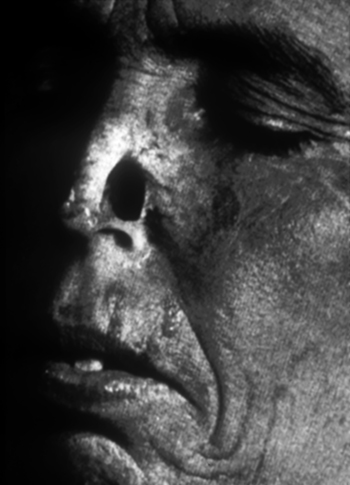
Dejan Grba, Syphilis, digital transparency, 1995.
Illness, contagious or not, naturally causes repugnance, particularly if manifested on the face. Visual identity stigmatized by illness carries a residue of repugnance not because it indicates the lack of health or even the proximity of death but because, being excluded from the realm of what we consider as normal, it signifies the night in which the visible features of the thing signified fade away and in which only the unsettled affect operates (Kristeva).
To sail into that night means to get abandoned of the natural light of reason (itself guided by the strategy of identity), deeply sensing the emergence of overwhelming desolateness. To sail into that night means to remain beyond language, beyond symbolic, to remain at the junction of certain inconceivable heterogeneous currents but without following any.
The day of the language follows after floating, filled with expectation, on the winds of memory, that covers shapes of everything it encounters, as well as the water follows every shape of a vase (Sloterdijk). The day of language, however, does not dawn over the plains of repugnance. It can be neither objectified, nor informed by language in any way. Even God of the Old Testament can not explain repugnance except by referring toward other repugnance: that her (a girl marked by the stigma of leprosy, whom Moses tries to cure) father spat at her face, to be ashamed for seven days? Let her be excluded for seven days from the community, and then be accepted again (IV Moz. 12, 14.).
Repugnance, thus, can not be commented upon – it can only be presented or suffered and so, as soon as I pause here I ran further, fearing that I might sink into the bottomless chatter (Plato). Spit or sign of illness on the depicted face indicate the incredibility of the represented but also the miasma of otherness that emanates from it, sucking us into decay, into sinking, fall, sin. We can in fact say that sin is a subjectivized repugnance (Sontag).
If subjectivized, repugnance creates the feeling of sin – in artistic representation of repugnance sin is highly contextualized. Stigmas of illness are therefore often effect of arrows sent to punish sinners by Apollo in Iliad, by Semitic God in Old Testament, by Christ in middle-age frescoes, and by the Nature in recent art. Cressida's leprosy in Cressida’s Testament by Hernis and smallpox of Madamme de Martreille in Liasons Dangereuses show the real face of the liar even against her own will (Sontag). The meaning of such depictions is always the necessary need of those who are polluted in any way for purification that is achieved by walking the path of expelled. Thus, in this new epoch the clinics appear exactly as places for exclusion and surveillance of the excluded ones (Foucault).
If, on the other hand, repugnance remains unsubjectivized, if it only drags us beyond language, beyond ‘me’ and ‘us’ – without moral lessons and recipes for cleansing its dishonor – we can only map it in representation, locating in it the play of normal, normed and natural with heterogeneous, peripheral, other. Thus we discover that the realm of repugnance and the realm of normal are compatible and mutually established. There is no signifying chain without a Chinese, an Arab, a Negro, which haunt the paranoid Whiteman, disturbing his sleep (Deleuze & Guatarri), as well as it can not exist without the unhealthy, without a woman, or homosexual – without anything that for the paranoid follower of rules represents the Other which resides on the edge of his world. On the other hand, neither an Arab, the unhealthy nor a woman can acquire their aura of otherness without the forced canon, without the Same.
Dejan Grba’s Face of Illness is a result of such mapping. It creates a space in which norms and canons of human facial look meet the visualization of archetypal charge present in certain words tabooed for their invoking of repugnance. These penetration-maps of unconscious contents incited by the names of sicknesses, are rendered by computer manipulation of various photographs of human face, linking the ruptures in speech (Freud) that appear as the result of mentioning the words that invoke repugnance with ruptures in the image that once was pure signifier, while here and now covered by innumerous other signifiers.
Face of Illness consists of forty transparencies (slides), each projected to the area of approximately ten square meters, which draws the viewer into the image and which, being visually overwhelming, compels one to the corporeal reaction (Barnett Newman). The projection is held in darkness, with soundtrack that utters an atmosphere of completely individual confrontation with maps or schemes of repugnance, always latent in our language and visual experience.
Stevan Vuković, Maps of Repugnance, Face of Illness installation brochure, CZKD, Belgrade, 1995.